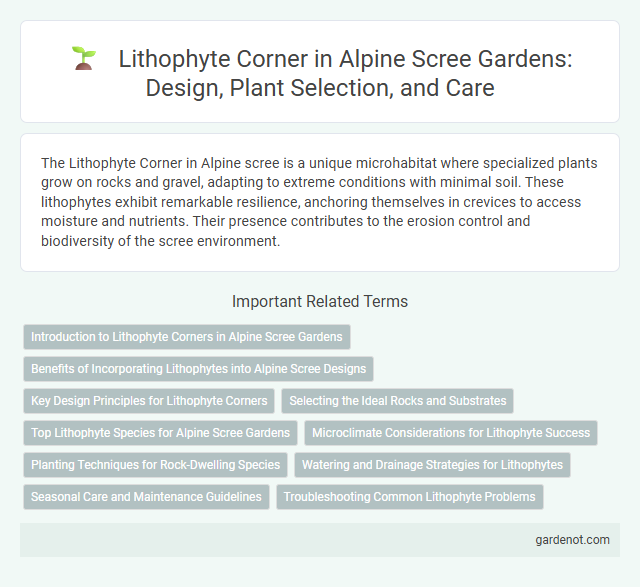The Lithophyte Corner in Alpine scree is a unique microhabitat where specialized plants grow on rocks and gravel, adapting to extreme conditions with minimal soil. These lithophytes exhibit remarkable resilience, anchoring themselves in crevices to access moisture and nutrients. Their presence contributes to the erosion control and biodiversity of the scree environment.
Introduction to Lithophyte Corners in Alpine Scree Gardens
Lithophyte corners in alpine scree gardens showcase plants uniquely adapted to thrive on rocky substrates, where soil is minimal and drainage is rapid. These specialized garden areas mimic natural scree slopes, emphasizing the growth of lithophytic species that extract nutrients from rock crevices and withstand harsh alpine conditions. Incorporating diverse lithophytes enhances biodiversity and highlights the resilience of flora in extreme mountainous environments.
Benefits of Incorporating Lithophytes into Alpine Scree Designs
Incorporating lithophytes into alpine scree designs enhances biodiversity by supporting specialized plant species adapted to rocky substrates. These plants improve soil stabilization and water retention, reducing erosion on steep scree slopes. Their drought-resistant properties contribute to sustainable landscaping in harsh alpine environments, promoting ecological balance and aesthetic appeal.
Key Design Principles for Lithophyte Corners
Key design principles for lithophyte corners include selecting rock types that mimic natural alpine scree environments, ensuring adequate drainage to prevent waterlogging, and creating microhabitats that support diverse lithophytic plant species. Incorporating varied rock sizes and textures promotes natural water retention and root anchorage, essential for species such as Saxifraga and Draba. Positioning the corner to maximize sunlight exposure while providing wind protection enhances plant resilience and biodiversity.
Selecting the Ideal Rocks and Substrates
Selecting the ideal rocks and substrates for an alpine scree lithophyte corner requires prioritizing well-draining materials such as granite, quartzite, and schist that mimic natural mountain conditions. Rocks with rough textures and crevices provide essential anchorage for lithophyte roots and promote moisture retention while preventing waterlogging. Incorporating a mix of coarse gravel and sandy substrates enhances aeration and supports healthy root development in alpine scree environments.
Top Lithophyte Species for Alpine Scree Gardens
Top lithophyte species for alpine scree gardens include Saxifraga paniculata, Silene acaulis, and Sedum album, all known for their resilience on rocky substrates. These plants thrive in well-drained, nutrient-poor conditions, exhibiting specialized root systems that anchor into crevices of scree slopes. Their adaptive morphology and drought tolerance make them ideal candidates for sustainable alpine rock garden designs.
Microclimate Considerations for Lithophyte Success
Microclimate considerations are crucial for lithophyte success on alpine scree, where temperature fluctuations and moisture availability directly impact plant survival. These plants rely on sheltered crevices that retain humidity and moderate thermal extremes, providing stable conditions essential for growth. Understanding microhabitat variability aids in conserving lithophyte biodiversity in harsh alpine environments.
Planting Techniques for Rock-Dwelling Species
Lithophyte corner planting techniques emphasize selecting drought-tolerant species with shallow root systems that anchor securely in rocky crevices. Using minimal soil mixed with gritty substrates improves drainage and mimics natural scree conditions, preventing root rot. Strategic placement in angled niches maximizes moisture retention and sunlight exposure, optimizing growth for alpine scree plants.
Watering and Drainage Strategies for Lithophytes
Effective watering and drainage strategies are crucial for the health of lithophytes in the Alpine scree environment. These plants require well-drained substrates that mimic natural crevice conditions, preventing waterlogging while ensuring consistent moisture availability. Incorporating gravel or coarse sand enhances drainage, and frequent, light watering prevents root rot while supporting optimal growth.
Seasonal Care and Maintenance Guidelines
Seasonal care for Lithophyte corner involves monitoring moisture levels closely during spring and fall when precipitation varies, ensuring substrate remains damp but not waterlogged. In winter, protect plants from frost by applying mulch or relocating sensitive species indoors to prevent root damage. Summer maintenance includes regular pruning of dead foliage and controlling weeds to reduce competition for nutrients and water in the rocky alpine scree environment.
Troubleshooting Common Lithophyte Problems
Lithophyte health often declines due to inadequate moisture and poor drainage, leading to root rot or fungal infections in Alpine scree habitats. Ensuring proper rock substrate composition and maintaining optimal humidity levels are critical for preventing these issues. Regular monitoring for pests like aphids and mite infestations helps preserve lithophyte vitality in challenging scree environments.
Lithophyte corner Infographic

 gardenot.com
gardenot.com